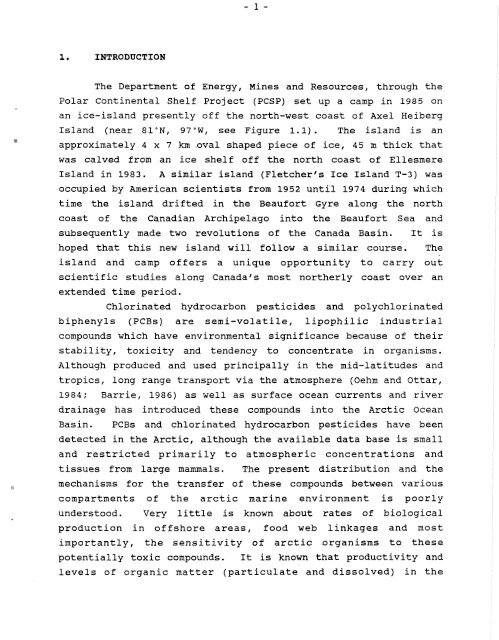Distribution of Chlorinated Hydrocarbon Pesticides and PCBs in the ...
Distribution of Chlorinated Hydrocarbon Pesticides and PCBs in the ...
Distribution of Chlorinated Hydrocarbon Pesticides and PCBs in the ...
Create successful ePaper yourself
Turn your PDF publications into a flip-book with our unique Google optimized e-Paper software.
INTRODUCTION<br />
The Department <strong>of</strong> Energy, M<strong>in</strong>es <strong>and</strong> Resources, through <strong>the</strong><br />
Polar Cont<strong>in</strong>ental Shelf Project (PCSP) set up a camp <strong>in</strong> 1985 on<br />
an ice-isl<strong>and</strong> presently <strong>of</strong>f <strong>the</strong> north-west coast <strong>of</strong> Axel Heiberg<br />
Isl<strong>and</strong> (near 81°N, 97"W, see Figure 1.1). The isl<strong>and</strong> is an<br />
approximately 4 x 7 km .oval shaped piece <strong>of</strong> ice, 45 m thick that<br />
was calved from an ice shelf <strong>of</strong>f <strong>the</strong> north coast <strong>of</strong> Ellesmere<br />
Isl<strong>and</strong> <strong>in</strong> 1983. A similar isl<strong>and</strong> (Fletcher's Ice Isl<strong>and</strong> T-3) was<br />
occupied by American scientists from 1952 until 1974 dur<strong>in</strong>g which<br />
time <strong>the</strong> isl<strong>and</strong> drifted <strong>in</strong> <strong>the</strong> Beaufort Gyre along <strong>the</strong> north<br />
coast <strong>of</strong> <strong>the</strong> Canadian Archipelago <strong>in</strong>to <strong>the</strong> Beaufort Sea <strong>and</strong><br />
subsequently made two revolutions <strong>of</strong> <strong>the</strong> Canada Bas<strong>in</strong>. It is<br />
hoped that this new isl<strong>and</strong> will follow a similar course. The<br />
isl<strong>and</strong> <strong>and</strong> camp <strong>of</strong>fers a unique opportunity to carry out<br />
scientific studies along Canada's most nor<strong>the</strong>rly coast over an<br />
extended time period.<br />
<strong>Chlor<strong>in</strong>ated</strong> hydrocarbon pesticides <strong>and</strong> polychlor<strong>in</strong>ated<br />
biphenyls (<strong>PCBs</strong>) are semi-volatile, lipophilic <strong>in</strong>dustrial<br />
compounds which have environmental significance because <strong>of</strong> <strong>the</strong>ir<br />
stability, toxicity <strong>and</strong> tendency to concentrate <strong>in</strong> organisms.<br />
Although produced <strong>and</strong> used pr<strong>in</strong>cipally <strong>in</strong> <strong>the</strong> mid-latitudes <strong>and</strong><br />
tropics, long range transport via <strong>the</strong> atmosphere (Oehm <strong>and</strong> Ottar,<br />
1984; Barrie, 1986) as well as surface ocean currents <strong>and</strong> river<br />
dra<strong>in</strong>age has <strong>in</strong>troduced <strong>the</strong>se compounds <strong>in</strong>to <strong>the</strong> Arctic Ocean<br />
Bas<strong>in</strong>. <strong>PCBs</strong> <strong>and</strong> chlor<strong>in</strong>ated hydrocarbon pesticides have been<br />
detected <strong>in</strong> <strong>the</strong> Arctic, although <strong>the</strong> available data base is small<br />
<strong>and</strong> restricted primarily to atmospheric concentrations <strong>and</strong><br />
tissues from large mammals. The present distribution <strong>and</strong> <strong>the</strong><br />
mechanisms for <strong>the</strong> transfer <strong>of</strong> <strong>the</strong>se compounds between various<br />
compartments <strong>of</strong> <strong>the</strong> arctic mar<strong>in</strong>e environment is poorly<br />
understood. Very little is known about rates <strong>of</strong> biological<br />
production <strong>in</strong> <strong>of</strong>fshore areas, food web l<strong>in</strong>kages <strong>and</strong> most<br />
importantly, <strong>the</strong> sensitivity <strong>of</strong> arctic organisms to <strong>the</strong>se<br />
potentially toxic compounds. It is known that productivity <strong>and</strong><br />
levels <strong>of</strong> organic matter (particulate <strong>and</strong> dissolved) <strong>in</strong> <strong>the</strong>

















